
Sustained Footwear Characteristics across Athletic Footwear over Several Years: A Case Study of Impression Wear Patterns for Investigative Value
*Corresponding Author(s):
Lee MWDepartment Of Criminal Justice Administration, Middle Tennessee State University, United States
Tel:+1 615-898-2300,
Email:Lee.Wade@mtsu.edu
Abstract
This limited study evaluated footwear characteristics related to wear patterns and their growth over time with athletic shoes used in potential crime scenes. In a case study involving two potential suspects with similar footwear, geometric and sustained wear characteristics were found to be consistent throughout years of wear by the suspects. The investigative value of how documentation of these wear patterns with potential, serial suspects is discussed.
Keywords
Athletic footwear; Crime scene evidence; Footwear Patterns; Investigations
INTRODUCTION
In recent years, crime scene investigation techniques that are published, researched, and featured are primarily focused on DNA and/or fingerprinting methods. Unfortunately, there have been fewer studies and features on footwear identification processes in the media or in academia. This could be attributed to the differences in these methods due to investigative efficiency, validity, and probability of effecting an identification of a suspect. Furthermore, there seems to be more resources allocated toward non-footwear type evidence and using database systems at federal, state, and local levels with these methods. These techniques related to DNA and fingerprint methods have had much investment by stakeholders to further increase their use and remain at the forefront of investigative goals. Despite the popularity of these methods, footwear evidence left at a crime scene remains one of the oldest and most abundant evidence in a crime scene. Often, as an overlooked piece of evidence, footwear investigative techniques still have value in producing leads or confirming suspect identification in many criminal cases.
Due to decentralization of police services in the United States, the resources available for law enforcement investigative methods have variation across approximately 18,000 jurisdictions. In some areas, the need for investigative leads also varies depending on the case facts, crime scene, and resources throughout the investigation. The use of footwear impression evidence left at the crime scene can be useful with cases that have possible suspects connected via testimonial evidence. Identification of suspects is possible through individual characteristics related to specific factors throughout the life of usage of footwear [1]. However, with athletic footwear, some brands are ubiquitous and used by various samples of persons within the population of any jurisdiction [2]. In some serial crimes, impression patterns can be found frequently with both class and random characteristics. Some wear patterns are consistent and can be left on substrates throughout the crime scene [3]. Careful documentation and collection of evidence related to these patterns in a crime scene can be of investigative value, especially when used consistently by suspects. This study evaluated a case in which wear patterns from similar footwear were found to be consistent throughout the life of the shoe, and it puts forward the argument that documenting the growth of the wear patterns can have some value in an investigation.
LITERATURE REVIEW
Footwear evidence, for investigative purposes, can be impacted by many factors to include manufactured design, manufactured materials, the suspects’ weight, suspects’ gait, and the substrate the footwear impacts with at a crime scene. Identifications can be based upon random characteristics and class characteristics are possible if a suspect’s shoes are obtained for comparison. Certain class characteristics like the pattern of the outsole, size of the shoe, and shape of the outsole that is in line with a logo or fashion from a manufacturer. There can be some distortion in impression evidence depending on the gait of the individual and their foot injuries. Furthermore, how the weight and gait of individual impact the footwear dynamics can result in outsole pattern wear. This can range from normal wear to overloaded metatarsal conditions that exist for the individual [4]. According to , there are three critical areas of investigative value concerning footwear impressions. The first is evaluating the physical characteristics of the outsoles of the footwear. The second knows the manufacturing brand, design, and process of the footwear. Thirdly, which is the focus of this inquiry, the wearing of the footwear by the individual is also critical. Furthermore, any detail, to include wear characteristics may be important to the comparison process, and wear characteristics can change due to the use of footwear over time [5] stated, “The more extensive the wear, the more original the appearance will appear when compared to another outsole of the same design” [6] argued that clustering of footwear patterns can aid in the comparison of footwear evidence by the examiner. Furthermore, by selecting geometric shapes to cluster outsole design patterns, actual databases of recorded impressions can be searched and retrieved using specific algorithms. Therefore, certain wear patterns can be categorized and documented to the point of database inclusion. As such, the London Metropolitan Police normally take a scan of suspect taken into custody to record their specific footwear. Moreover, if individual characteristics emerge from wear patterns, the probability of including the footwear evidence in individualization increases. “A database of outsole patterns may not only provide the pattern prevalence but also more specific and minute characteristics such as type, size, common wear patterns and individual damages, which could be used in different comparison procedures [7] . In terms of establishing a database, or even just documenting patterns related to footwear the British have identified profiles associated with athletic shoes in serial crimes. One study indicated a correlation between the high frequency of athletic shoe wear among burglars to approximately 94% of all residential burglaries over a few years.
CASE STUDY & RESULTS
The footwear in this case study are from two potential suspects, and the color, medium-resolution photographs were taken of the outer soles of these footwear. The focus of the footwear impression to compare was of one particular brand of athletic shoes. Various sets of shoes were obtained from two potential suspects. Photographs were taken of both sets from the suspects of their footwear that include some casual shoes as well. Resolution of the photographs was a challenge due to the date of investigation and obtaining the exemplar footwear from suspects. For this evaluation, there are six photographs from multiple brands of shoes for potential suspect 1 (PS1), and there are two photographs from a second potential suspect (PS2). These are older photographs, which is why the resolution is approximately 300 to 400 dpi. The height and weight of potential suspects 1 (PS1) and 2 (PS2) were similar at approximately 5 foot 10 inches and both weighing approximately 180 pounds. The type of shoes primarily of interest was similar brand athletic, running shoes between both potential suspects. Other shoes obtained from PS1 were a different brand of running shoe and casual shoe for wear comparison. All outer sole documentation originated from the left footwear from PS1 and PS2. For footwear associated with PS1, athletic, running shoes 1 and 2 were worn for over four years (Figure 1) and two to three years (Figure 2) respectively. Running shoe 1 showed a larger area of wear characteristics that is located primarily in the forefoot zone. In the midfoot zone, there is crushed damage to the outer sole that is significant.
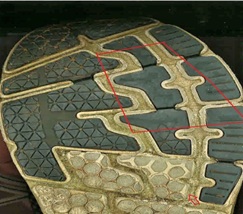
Figure 1: Running Shoe 1
Running shoe 2, which is the younger of this shoe brand in terms of wear, had more random characteristics associated with dirt and grass. Again, in terms of wear characteristics, the wear pattern is located primarily in the forefoot region and slightly to the right, just like in running shoe 1, but it is less spread out. There is minor crush damage to the outer sole located in the midfoot region. Running shoes 1 and 2 are the same brand and style from PS1. From this comparison of running shoes 1 and 2, the wear pattern from PS1 appears to originate in middle-right and begins to spread over time and a wider area after year 3 of use. 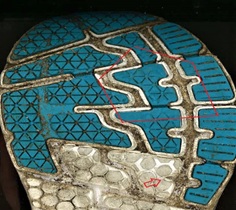 Figure 2: Running Shoe 2
Figure 2: Running Shoe 2
Running shoes 3 and 4 were of the same brand of athletic running shoe that PS1 wore after running shoes 1 and 2. Running shoe 3 had been worn by PS1 for approximately 6 months to 1 year, and running shoe 4 had been worn for approximately 2 years. The outer sole pattern and composition were different across these shoes, where one could infer the materials were sturdier in design. Running shoe 3 had wear characteristics originating in the same middle-right area of the forefoot, but it was less pronounced compared to running shoes 1 and 2. There was degradation and wear damage in the midfoot area consistent with running shoes 1 and 2 (Figure 3).
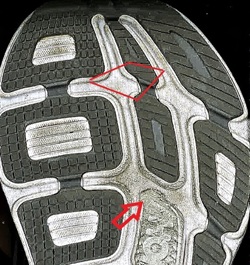 Figure 3: Running Shoe 3
Figure 3: Running Shoe 3
Running shoe 4 had been worn for approximately 2 years or more. Although a different shoe, the brand and model was the same as running shoe 3. The wear pattern characteristics appears to originate in the same area as running shoe 3, but has more wear from forefoot to midfoot. The midfoot wear pattern that is consistent with the first three footwear appears to be larger as well in the damage and wear of brand name. From the comparison of these two shoes, one could infer that the wear patterns are consisted across all four footwear, but the outsole materials impacted the spread of wear characteristics (Figure 4).
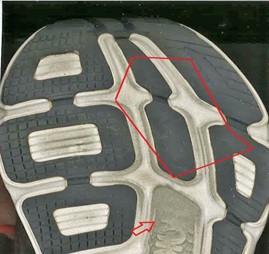 Figure 4: Running Shoe 4
Figure 4: Running Shoe 4
Running shoe 5 and casual shoe 1 were evaluated to see if sustained wear characteristics were consistent across other brands of athletic shoes and materials. Running shoe 5 had been worn for approximately 6 months, and casual shoe 1 had been worn by PS1 for approximately 1 to 2 years. Running shoe 5 had significant wear pattern characteristics in the middle-right section of the forefoot, which is consistent with the other running shoes from PS1. The wear pattern, however, was more concentrated in the middle and wide across the forefoot in comparison to the other running footwear. Please note the Schallamach pattern in (Figure 5) which is consistent with short term wear patterns. Furthermore, running shoe 5 had a wear pattern in the midfoot consistent with running shoes 1 through 4.
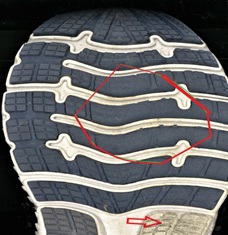 Figure 5: Running Shoe 5
Figure 5: Running Shoe 5
Casual shoe 1 had similar wear characteristics as running shoe 5, which is more in the middle of the forefoot, but also showing wear to the right of the middle. Please note the Schallamach pattern in the center area. The forefoot region appears to be consistent with the preceding five footwear for comparison. One important difference is there was no midfoot wear or damage to the outsole that was present in the athletic footwear. This could be attributed to the angle in which the casual shoe strikes the surface upon wear and the materials of the outsole design (Figure 6).
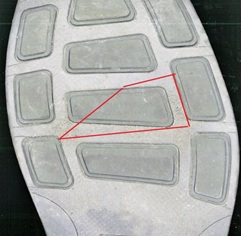 Figure 6: Running Shoe 6
Figure 6: Running Shoe 6
From the comparison of these two footwear from PS1 with each other and the other athletic running shoes, one can observe a sustained set of wear pattern characteristics that appear to be mitigated by the shoe outsole design and brand. PS1 seems to wear out their footwear in the middle-right forefoot area of each shoe, and would also have some impact wear damage or wear in the center-right of the midfoot zone. As a control, possible suspect 2’s (PS2) footwear was evaluated. Unfortunately, we were only able to obtain two sets of footwear from PS2. These footwear are also athletic running shoes, and PS2 was selected because of the brand of athletic shoe used for comparisons to PS1’s footwear. In this comparison of sustained wear characteristics, the brand is the same for footwear, but there were two different models/designs evaluated for PS2.
Running shoe 7 from PS2 is the same brand of athletic shoe of running shoe 1 and 2 PS1, and it is assumed the same design and material for the outsole. Running shoe 7 was worn for approximately 2 years by PS2. From running shoe 7, one can observe the wear characteristics for PS2 originates on the extreme right side of the shoe, and the pattern extends from the forefoot across the midfoot and ending in the rear foot. The wear pattern from PS2 causes some of the material to be worn completely off in addition to a smoothing effect (Figure 7).
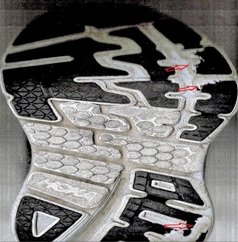 Figure 7: Running Shoe 7
Figure 7: Running Shoe 7
Running shoe 8 from PS2 was an athletic shoe from the same brand, but different model and outsole design in comparison to running shoe 7. PS2 had worn running shoe 8 for approximately 5 years. As such, the wear pattern characteristics were similar to running shoe 7 where the wear begins on the extreme right side of the shoe, and the pattern extends from the forefoot through to the rear foot. The pattern, after several more years of wear, is more pronounced compared to running shoe 7. The wear characteristics in the midfoot zone extend to from the right to the middle of the footwear. The wear pattern is also substantial to the point of wearing out the outsole design completely and creating a smoothing effect (Figure 8).
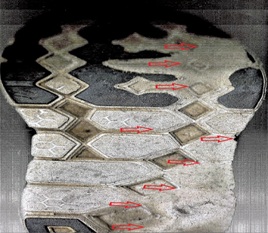 Figure 8: Running Shoe 8
Figure 8: Running Shoe 8
DISCUSSION
For traditional investigative value, the individual characteristics found from a footwear impression in a crime scene can create a lead associated with a potential suspect, provided an exemplar footwear is found connected to the suspect. The purpose here is to evaluate characteristics that are constant and attributed to an individual through similar footwear and tread manufactured materials. Wear patterns can be used in association with random characteristics to lead to an identification. However, as clearly has shown in his research, the wear pattern, sans random characteristics, might not be an exact wear pattern on another shoe. Moreover, attributed this to the micro-cellular material and more wear. Given the foundation here for research, what we can consider is that after significant wear (same shoe + time worn) for athletic shoes, a growth, wear pattern will emerge that can be consistent across footwear with similar materials in the outsole pattern. What makes this slightly significant is the trend of athletic footwear usage in the commission of crimes. Furthermore, we argue that if local databases are developed to store footwear impressions, agencies should document and include estimated time of wear on each scan of the impression, but also remarking on location wear of the outsole and Schallamach patterns if present. There are limitations to classify footwear impression evidence, especially when footwear characteristics are concerned. Concerning evaluating patterns from exemplars to impression evidence, some examiners may have differing classifications of comparisons, some may have different laboratory definitions, and some may have differing interpretations of wear patterns [8] of ten laboratories across seven countries showed variation in interpretation of two sets of footwear impressions as evidence. Not only was there variation in definitions, but in the probability that the impression matched the exemplar. Anecdotally, any lead in an investigation is a lead of value, especially in cases where there are no tangible leads from a crime scene. If one has worked criminal cases where the only evidence is a footwear impression, the application of any method to confirm leads may be important to emphasize for the investigator and/or examiner. This case study has indicated that documentation of geometric patterns of wear in athletic footwear is sustained over time. Therefore, in terms of profiling or evaluating suspects, the void left in an impression where the wear pattern can be inferred may have some value. If so, then, this could be documented by investigators or agencies in a local database. Furthermore, the documentation could have value for footwear examiners in looking at probable cases of identification.
REFERENCES
- Bodziak W (1990) Footwear impression evidence. New York: Elsevier.
- Tonkin M, Bond JW, Woodhams J (2009) Fashion conscious burglars? Testing the principles of offender profiling with footwear impressions recovered at domestic burglaries. Psychology, Crime & Law, 15: 327-345.
- Davis M (2009) The forensic analysis of footwear impression evidence. Forensic Science Communications 11: 1-9.
- Lucock L (1979) Identification from footwear. Medical Science Law 19: 225-229.
- Hilderbrand D (1999) Four basic components of a successful footwear examination. Journal of Forensic Identification 49: 37-59.
- Tang Y, Srihari SN, Kasiviswanathan H, Corso JJ (2010) Footwear print retrieval system for real crime scene marks. In International workshop on computational forensics Pg. No: 88-100.
- Johansson A, Stattin T (2008) Footwear Impression as Forensic Evidence-Prevalence, Characteristics and Evidence Value. Engineering 1-79.
- Shor Y, Weisner S (1999) A survey on the conclusions drawn on the same footwear marks obtained in actual cases by several experts throughout the World. Journal of Forensic Science 44: 380-384.
Citation: Lee MW (2020) Sustained Footwear Characteristics across Athletic Footwear over Several Years: A Case Study of Impression Wear Patterns for Investigative Value. Forensic Leg Investig Sci 6: 052.
Copyright: © 2020 Lee MW, et al. This is an open-access article distributed under the terms of the Creative Commons Attribution License, which permits unrestricted use, distribution, and reproduction in any medium, provided the original author and source are credited.

